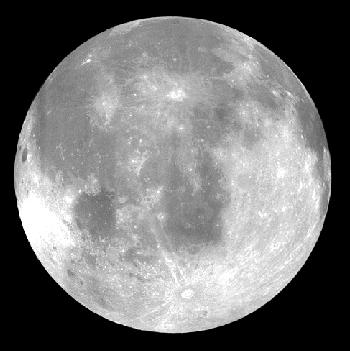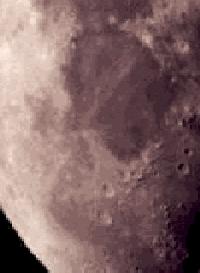Observing the Moon: Lunar Rays
Jack Kramer
One of the most obvious features that is especially visible on the full moon is the system of rays emanating from certain craters. These bright rays are so extensive that they are sometimes best observed using Earth-based telescopes, rather than up-close from a spacecraft. The image of the full moon below shows the network of rays covering the lunar surface. (Since it is from the Clementine spacecraft, the image is oriented a bit differently than from our Earthly perspective.) Despite their prominence during a full moon, most rays are barely visible when the solar illumination angle is low. On the other hand, some can be seen when the Sun's elevation is only 20o. Curiously, they are not always equally bright when under a similar illumination angle in the lunar morning and evening.

The origin of lunar rays is generally ascribed to ejecta - material that was hurled out when particles of rock crashed into the lunar surface, forming the craters. However, there are indications that secondary craters had a role in producing rays. Using near-IR reflectance spectra and radar maps, plus Clementine and Galileo mission multispectral imagery, it was found that the rays west and south of the Messier crater complex are dominated by fresh mare material. Also, analyses of imagery and radar data indicate that the Tycho ray that crosses much of Mare Nectaris is dominated by fresh local material excavated from secondary craters.
Many additional aspects of rays are not clearly understood. There is no satisfactory explanation for the different types of rays; those of Tycho are long and narrow whereas those of Copernicus are less well defined and wispy. It is thought that some rays shift slightly in position during a lunation (the 291/2-day cycle from one new moon to the next). Those emanating from the crater Proclus are notable in this regard. Theories have been put forward suggesting pitting or granulation of the surface to explain their nature and visibility at different solar illumination angles.
Many rays do not point exactly back to the crater from which they supposedly originated. About 40 years ago, it was proposed that their non-radial orientation was caused by the moon having rotated on its axis during the time that the more distant ejecta was in its ballistic trajectory. Material in low trajectories would fall sooner and have less deviation from radial. A model of the rays from the Tycho crater indicated that the pattern of deviations could be fit only if the lunar "day" were between 0.5 and 6.8 earth days long, not the 291/2 days that it currently is. Thus, some reasoned that the rayed craters were created when the Moon was only about 100 million years old. This was used to explain why only a few craters have rays -- because they were formed when the crust was very young. Since the end of the Apollo program, however, the rays are widely interpreted as the splash marks from very young craters, and the deviations seen are not considered statistically significant.
Despite the hundreds of years during which the moon has been observed through telescopes and via more recent close views from space vehicles, observational data is still needed to test the theories of the origin of bright rays and their nature. The Association of Lunar and Planetary Observers (ALPO) spearheaded a project to study the lunar rays.
The statistical study of the distribution of rays may lead to valuable results. For example, an observer might note their occurrence on low or high ground, on slopes turned toward or away from the origin of the system, or on smooth or rough ground, the presence of discontinuities or curved arcs and the avoidance of surface features. Other things to be noted are the association of rays with linear arrangements of craterlets, the divergence of rays from points other than the center of the 'parent' crater, and their becoming visible only at some distance from the point of origin.
In my photo below, notice how a single ray from the bright crater Menelaus in the upper right corner extends completely across Mare Serenitatis. It seems to line up almost perfectly with the ray from the crater Thales (the bright area almost at the limb of the moon).

To give you an idea of the sort of data that is especially useful, the following is a suggested observing program:
- The beginning, course and end of each ray should be recorded, along with the width and brightness.
- Look for variations in the brightness of a ray along either its length or width. If so, record the position and the time; the latter determines the angle of the Sun's rays.
- Carefully examine the nature of the lunar surface upon which the ray lies. There may be bright spots and craterlets or slight swellings or uplifts in the terrain that may mimic a ray.
- In recording the form of the ray, indicate whether it is straight or has branches or interruptions; record the positions of these accurately.
- At times when the ray is invisible look for detail within the ray that shows different colors of the lunar surface.
- Note the times at which rays appear and disappear in a series of lunations. (A lunation is the period of roughly 291/2 days from one new moon until the next.)
- Color filters can be tried and any changes in a ray's appearance in different colors should be recorded.
- Studies of the Polarization of light in observations may be interesting and worth doing.
- The selenographic observations can be compared with similar geological phenomena, if possible.
The following table lists those craters that are known to have ray systems associated with them.
Rayed Crater Name |
Lunar Latitude |
Lunar Longitude |
ANAXAGORAS |
73.4N |
10.1W |
ARISTARCHUS |
23.7N |
47.4W |
ARISTILLUS |
33.9N |
01.2E |
AUTOLYCUS |
30.7N |
01.5E |
BESSEL |
21.8N |
17.9E |
BIRT |
22.4S |
08.5W |
BYRGIUS A |
27.7S |
63.6W |
COPERNICUS |
09.7N |
20.0W |
EUCLIDES |
07.4S |
29.5W |
FURNERIUS A |
33.5S |
57.2E |
GEMINUS C |
33.9N |
56.8E |
GODIN |
01.8N |
10.2E |
HIND |
07.9S |
07.4E |
KEPLER |
08.1N |
38.0W |
LALANDE |
04.4S |
08.6W |
LANGRANUS |
08.9S |
60.9E |
MANILIUS |
14.5N |
09.1E |
MENELAUS |
16.3N |
16.0E |
MESSALA B |
37.1N |
57.6E |
MESSIER A |
02.0S |
46.9E |
OLBERS |
07.4N |
75.9W |
OLBERS A |
08.3N |
77.5W |
PETAVIUS B |
27.9S |
58.6E |
PROCLUS |
16.1N |
46.8E |
REINER GAMMA |
08.0N |
58.0W |
SIRSALIS |
12.5S |
60.4W |
SNELLIUS |
29.3S |
55.7E |
STEVINUS A |
32.1S |
51.9E |
STRABO |
61.9N |
54.3E |
TARUNTIUS |
05.6N |
46.5E |
THALES |
61.8N |
50.3E |
THEOPHILUS |
11.4S |
26.4E |
TIMOCHARIS |
26.7N |
13.1W |
TYCHO |
43.3S |
11.2W |
ZUCCHIUS |
61.4S |
50.3W |
Published in the August 1999 issue of the NightTimes





